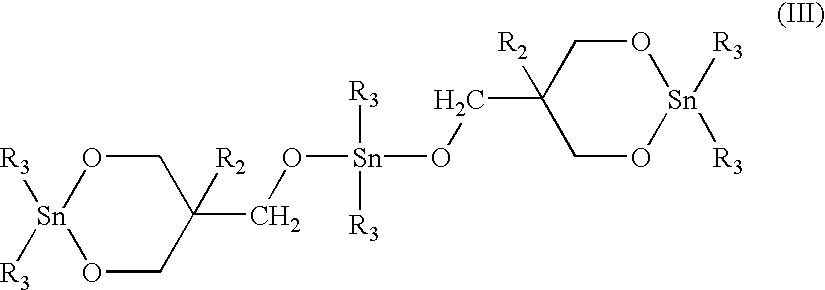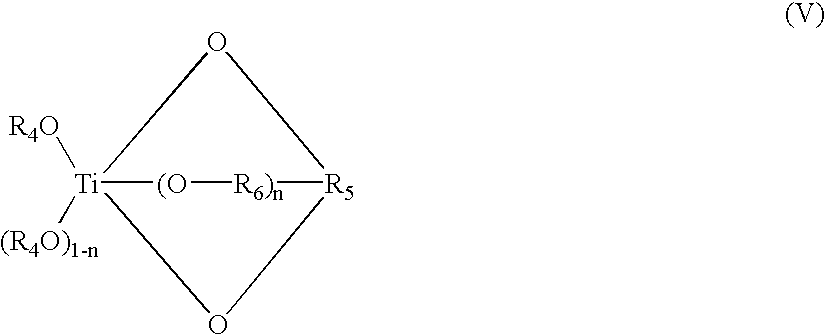Methods for converting linear polyesters to macrocyclic oligoester compositions and macrocyclic oligoesters
a technology of macrocyclic oligoester and composition, applied in the field of conversion of linear polyester to macrocyclic oligoester composition and macrocyclic oligoester, can solve the problems of increasing reaction rate, requiring expensive equipment, and many expensive finishing steps
- Summary
- Abstract
- Description
- Claims
- Application Information
AI Technical Summary
Benefits of technology
Problems solved by technology
Method used
Image
Examples
example 2
As an example of STEP 100, the pressure in the flask of Example 1 was reduced to 600 torr and distillation was continued at 195.degree. C. for 60 minutes. The pressure was reduced further as distillation of 1,4-butanediol was continued at 215.degree. C. / 150 torr for 45 min, 230.degree. C. / 40 torr for 40 min and 240.degree. C. / 10 torr for 40 min. The flask was cooled to 180.degree. C. and returned to atmospheric pressure, yielding a PBT of intermediate molecular weight of about 20,000 Daltons weighing 113 grams. The molecular weight of the intermediate molecular weight PBT is determined by gel permeation chromatography (GPC) relative to polystyrene standards using an Hewlett Packard HPLC, Model 1050 (Palo Alto, Calif.). The HPLC is equipped with a fixed wavelength detector set at 254 nM, two linear Phenogel GPC columns where each column measures 300 mm.times.7.8 mm and the Phenogel has a 5 micron particle size and maintained at a temperature of 40.degree. C. The solvent, chloroform (...
example 3
As an example of STEP 120 or STEP 220, ortho-dichlorobenzene (o-DCB), 1,300 ml, was added to the flask of Example 3 to produce a solution with 10% solids concentration. Heating under reflux was begun and o-DCB was removed by distillation. Samples of the product were periodically removed and their average molecular weight were determined as described above, by GPC relative to polystyrene standards using an Hewlett Packard HPLC, Model 1050 (Palo Alto, Calif.), and when the molecular weight value reached 100,000 Daltons, an additional 6.84 liters of o-DCB was added and heating under reflux was resumed for 1.5 hrs. The reaction was then quenched by the addition of 2 ml of water and 70% of the o-DCB was removed with 1,4-butanediol by azeotropic distillation, yielding a PBT composition enriched in macrocyclic oligomer content as analytically determined according to the above described methods by HPLC employing a Hewlett Packard HPLC, Model 1110 (Palo Alto, Calif.).
example 4
As an example of STEP 140 or STEP 240, the composition of Example 3 was cooled to 70.degree. C. and insoluble linear polyester was removed by filtration using a Buchner fimnel under vacuum conditions. The filtrate was passed through an alumina column to remove additional linears including residual end groups; combined linears could be recycled for conversion to cyclics or conversion by depolymerization to dimethyl terephthalate. Suitable alumina is alumina with Brockman Activity Grade I available from Whatman (Clifton, N.J.) that is packed into a standard laboratory column.
Further concentration to 50% solids was effected by o-DCB stripping which was determined effected when a quantity of o-DCB was condensed off of the process. Heptane was introduced in a threefold volume amount, resulting in the precipitation of the desired macrocyclic PBT oligomer mixture, which was removed by filtration and dried in vacuum. The macrocyclic PBT could be polymerized by contact with a stannoxane cata...
PUM
| Property | Measurement | Unit |
|---|---|---|
| temperature | aaaaa | aaaaa |
| temperature | aaaaa | aaaaa |
| temperature | aaaaa | aaaaa |
Abstract
Description
Claims
Application Information
 Login to View More
Login to View More - R&D
- Intellectual Property
- Life Sciences
- Materials
- Tech Scout
- Unparalleled Data Quality
- Higher Quality Content
- 60% Fewer Hallucinations
Browse by: Latest US Patents, China's latest patents, Technical Efficacy Thesaurus, Application Domain, Technology Topic, Popular Technical Reports.
© 2025 PatSnap. All rights reserved.Legal|Privacy policy|Modern Slavery Act Transparency Statement|Sitemap|About US| Contact US: help@patsnap.com



